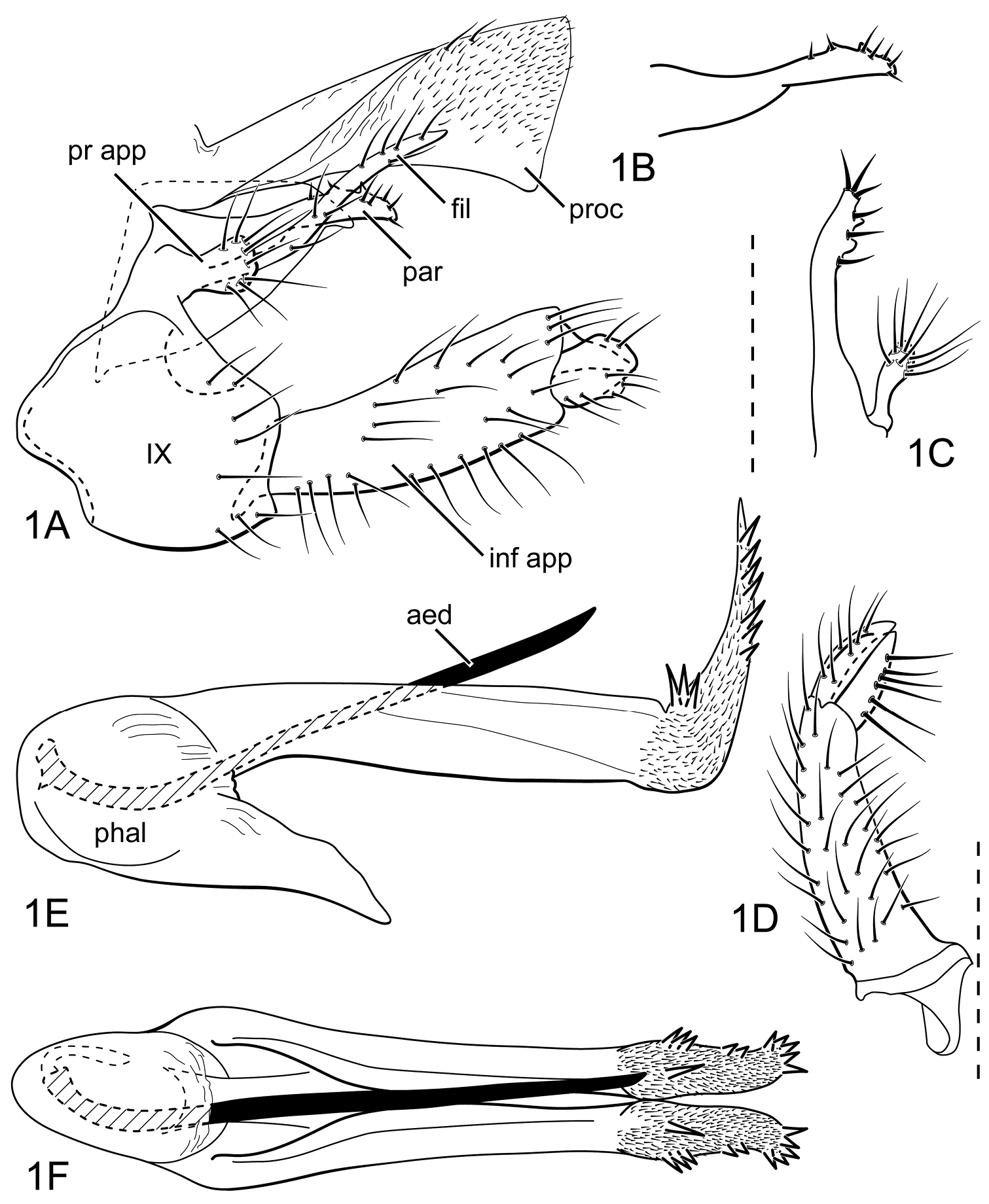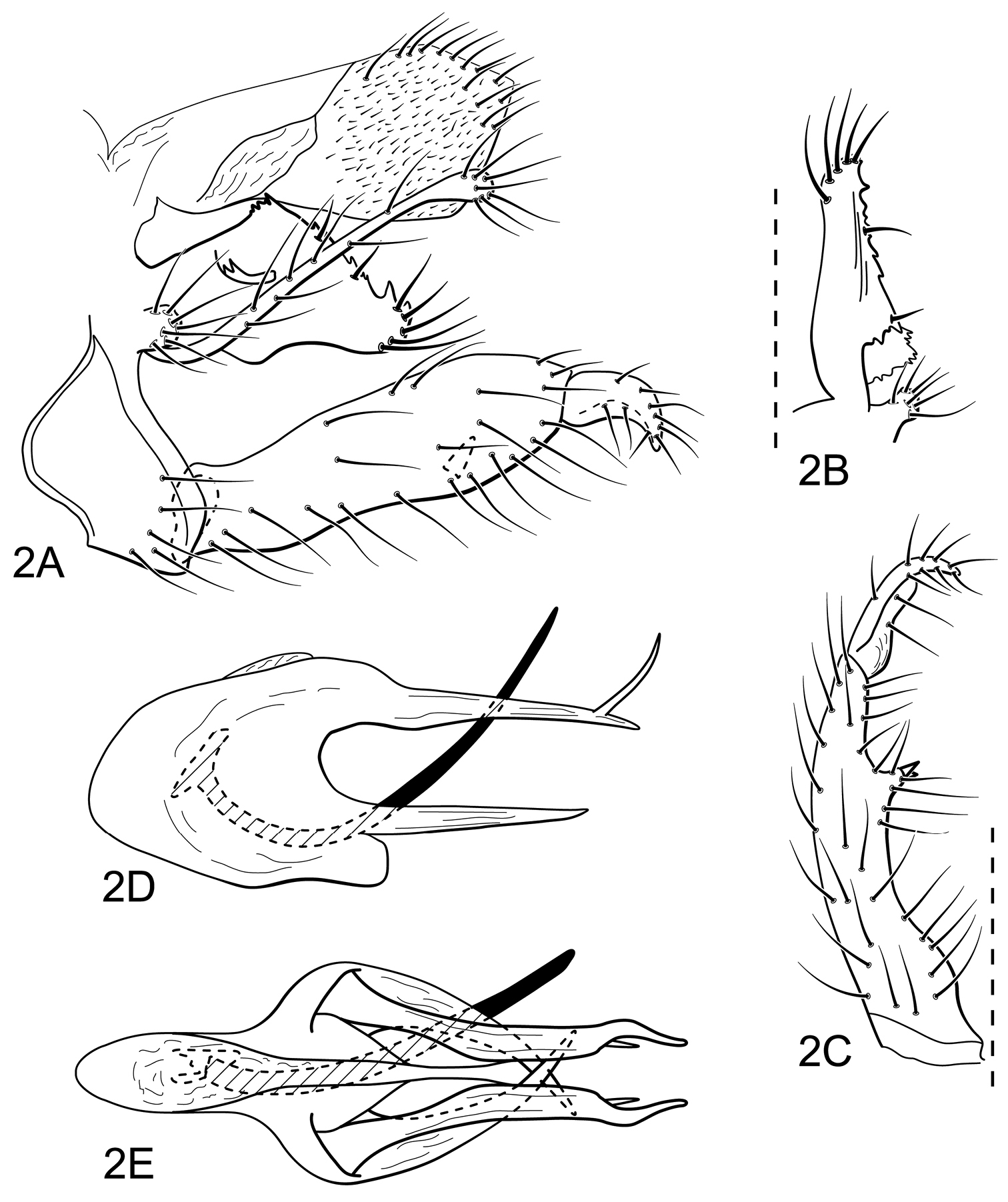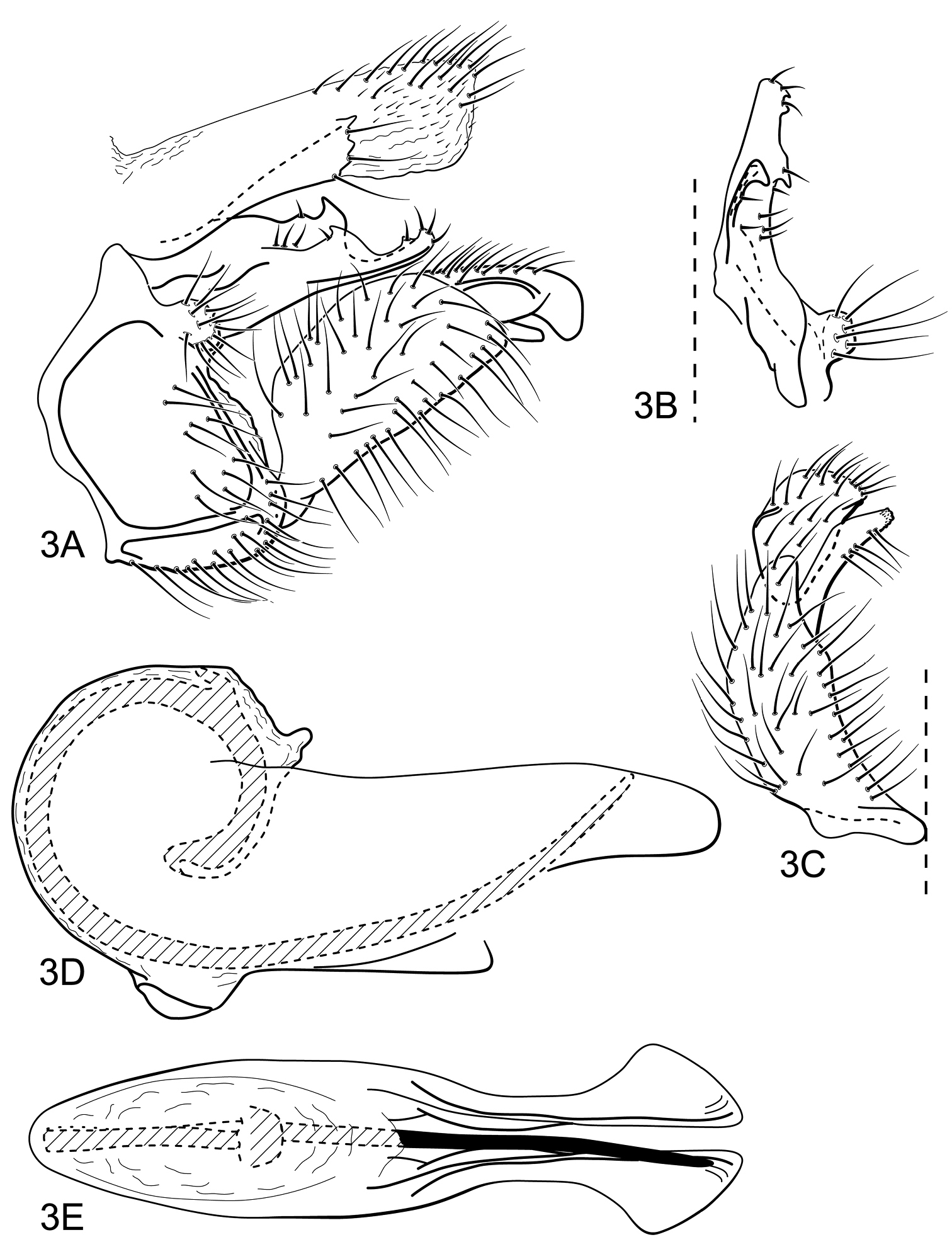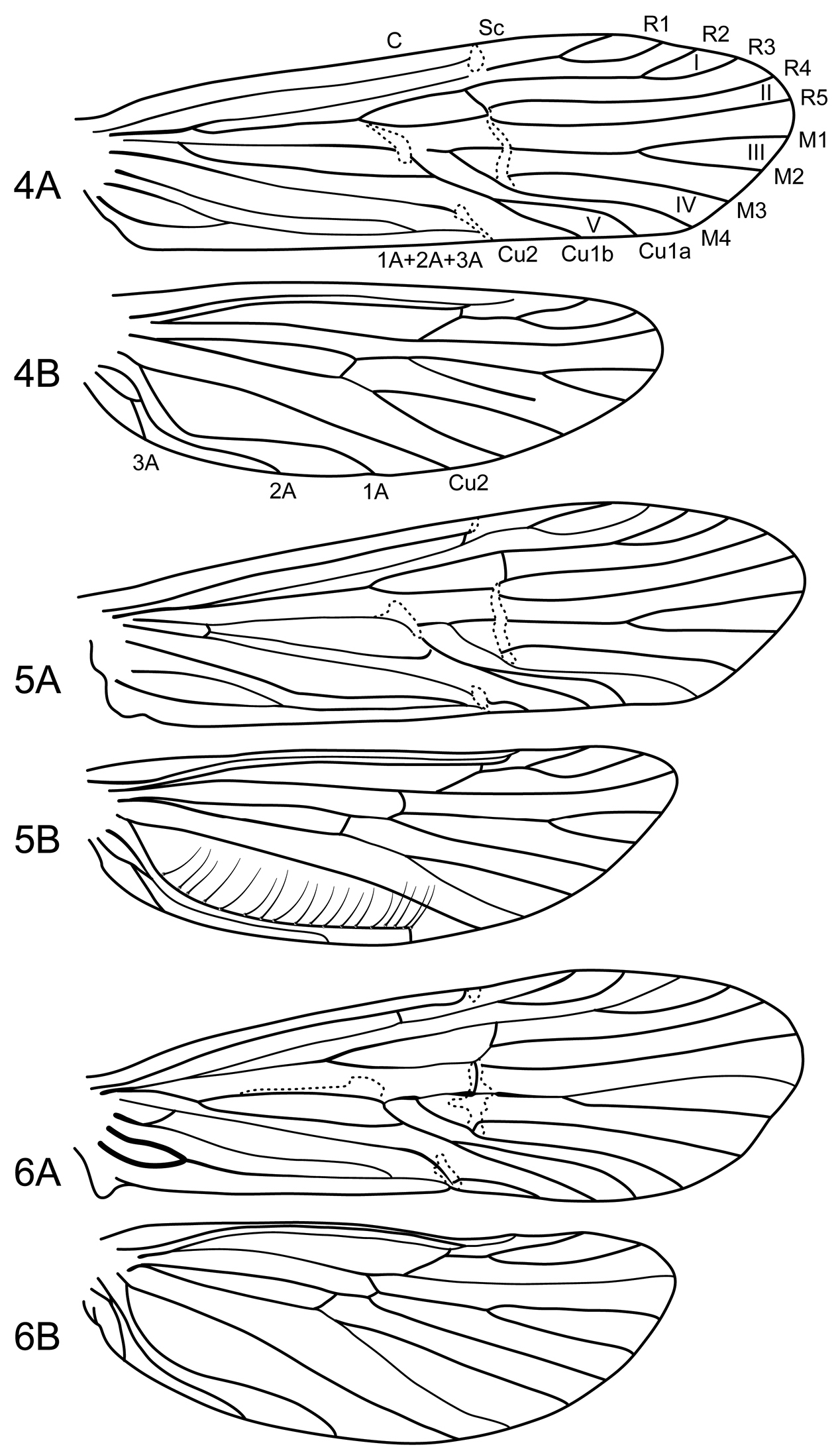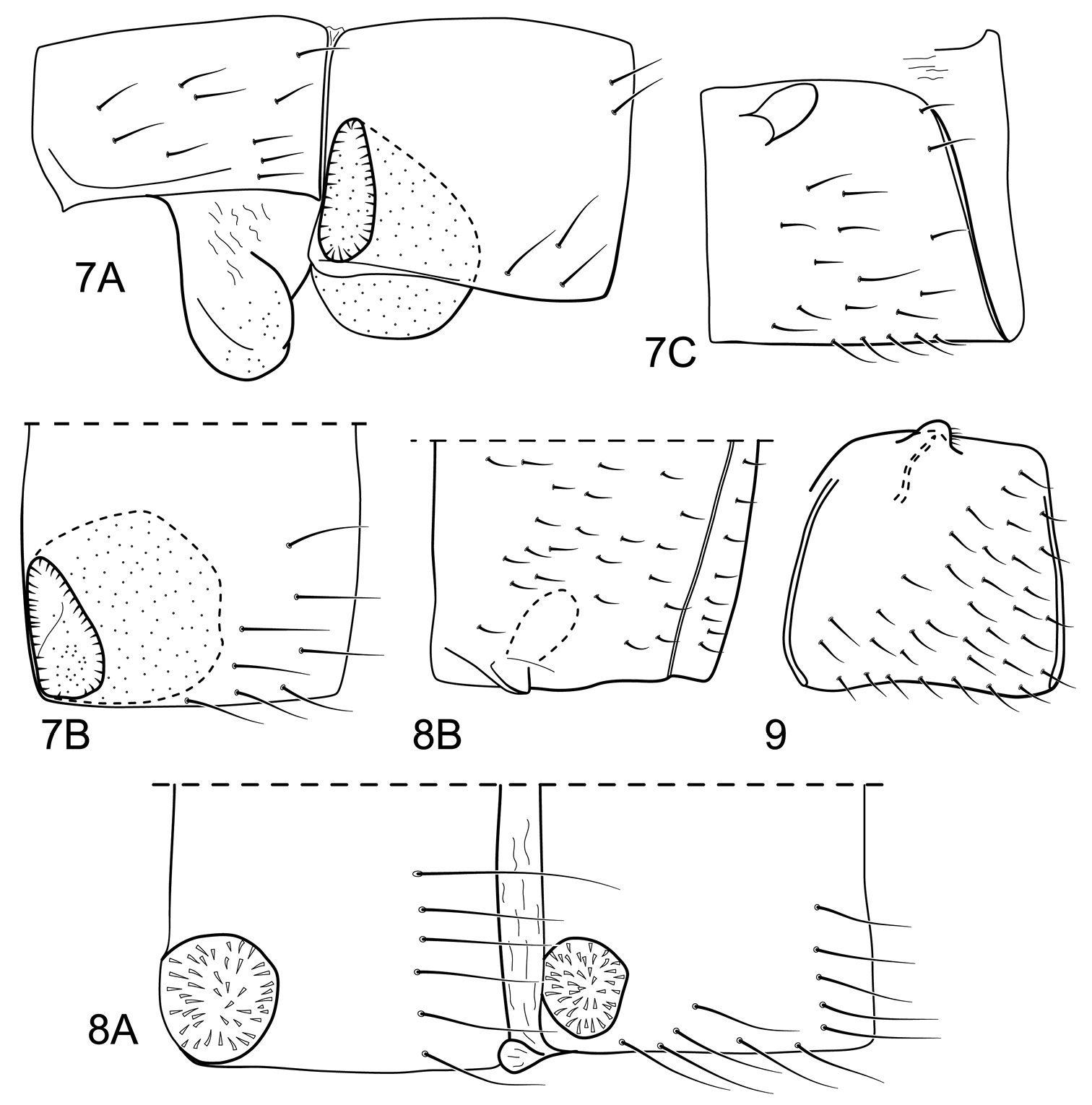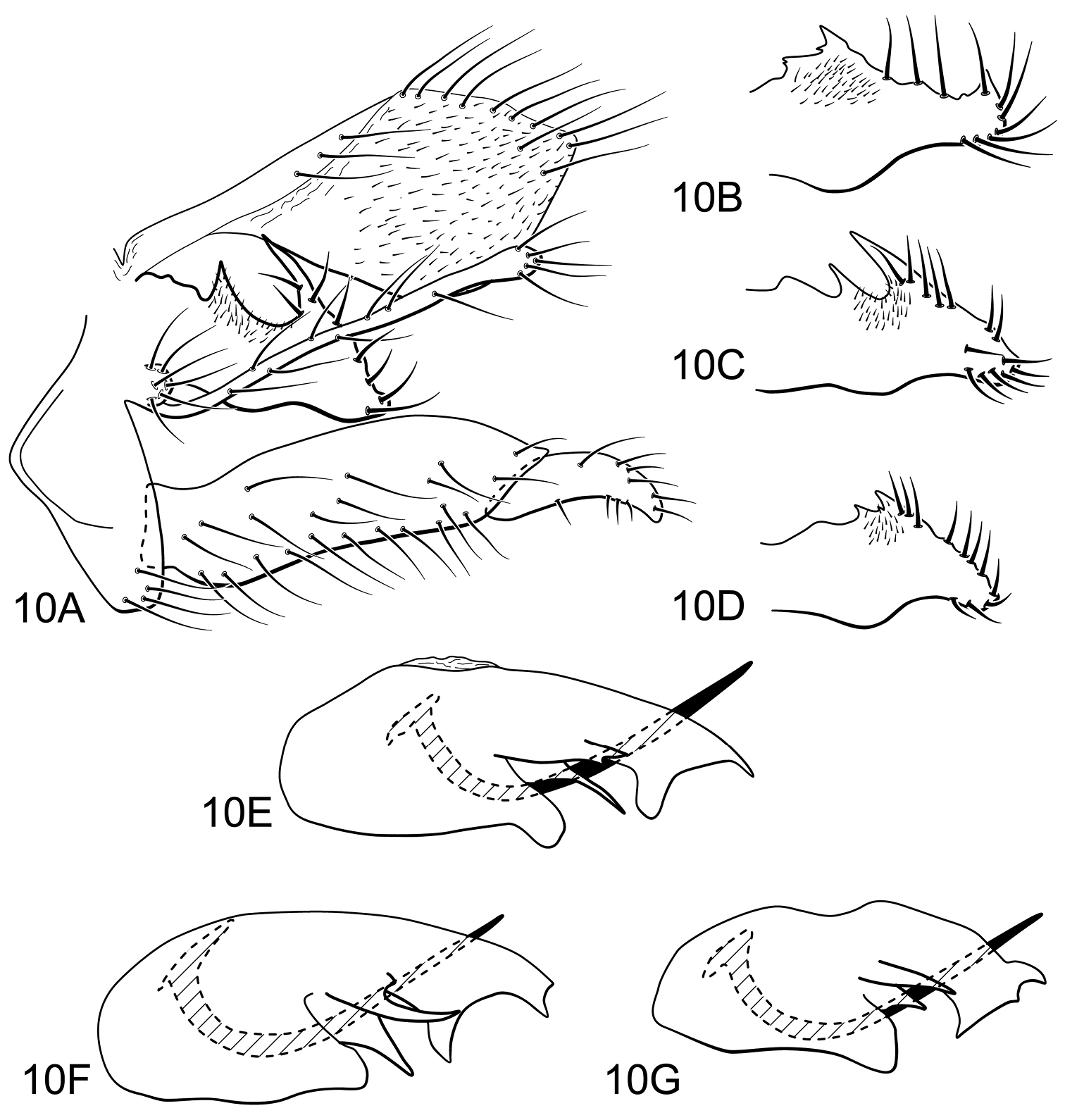






(C) 2012 Allan P. M. Santos. This is an open access article distributed under the terms of the Creative Commons Attribution License 3.0 (CC-BY), which permits unrestricted use, distribution, and reproduction in any medium, provided the original author and source are credited.
For reference, use of the paginated PDF or printed version of this article is recommended.
Three new species of Atopsyche Banks (Hydrobiosidae) from Brazil are described and illustrated: Atopscyhe (Atopsaura) blahniki sp. n., Atopsyche (Atopsyche) parauna sp. n., and Atopsyche (Atopsaura) galharada sp. n. Additional illustrations of the male genitalia of Atopsyche urumarca Schmid are provided, including its populational variation. Also, we provide new state records for 2 species: Atopsyche (Atopsyche) urumarca from São Paulo, and Atopsyche (Atopsaura) plancki Marlier from Santa Catarina.
Atlantic forest, Atopsyche, Brazil, caddisfly, Hydrobiosidae, Neotropics
Atopsyche Banks constitutes the most diverse genus in the family Hydrobiosidae, with over 120 described species (
In this paper, we describe 3 new species of Atopsyche from southeastern Brazil. These additional species bring the number of known caddisflies species from Brazil to 569, but many species of this and other genera remain undescribed. In addition, we illustrate variations in the male genitalia of Atopsyche urumarca Schmid, and provide new state distributional records of Atopsyche urumarca from São Paulo and Atopsyche plancki Marlier from Santa Catarina.
Material and methodsMorphological terminology used in this paper follows that presented by
urn:lsid:zoobank.org:act:17398E47-24AC-45A6-8FEF-CF2B3A9BBFE2
http://species-id.net/wiki/Atopsyche_blahniki
Figs 1, 4, 7This new species is most similar to Atopsyche zernyi Flint, also described from Brazil. Both species have an apical process on the first article of the inferior appendage as long as the second article, and a phallotheca with long paired processes, apically upturned and narrow. However, Atopsyche blahniki sp. n. differs from Atopsyche zernyi by the narrower parapod, longer filipod (exceeding length of parapod), and in the apices of the paired processes from the phallotheca, which bear several spines on their lateral edges.
Forewing length 5.5 mm (n=1). Overall body color brown; antennal scape brown, with long brown setae, pedicel brown, basal flagellomeres yellow, apical flagellomeres brown; setae of palps yellow; frons and vertex of head with long, erect brown and whitish setae; legs yellowish brown, coxae and femora of forelegs darker brown. Forewings brown; erect setae on veins forming irregular pattern of alternate dark brown and yellow setae; apex of wing with fringe of alternating patches of dark brown and yellow setae. Forewing venation complete (Fig. 4A); R1 branched; stem of fork I about twice its length; fork II long, sessile; stem of fork III equal to its length; fork IV long, sessile; stem of M almost straight between m-cu crossvein and first fork of M; fork V long, narrow; Cu2 long, converging near fused anal veins; apex of fused anal veins very short. Hind wing (Fig. 4B) with Sc and R1 fused apically; forks I, III, and V present, the first with a short stem, the last long with a short stem, stem of fork III equal to its length; forks II and IV absent; M3+4 not reaching wing margin; Cu2 long and almost straight; 1A long and sinuate. Nygmas indistinct in both wings. Tergum II with pair of prominent glands at posterolateral margin (Fig. 7A); tergum III with pair of prominent gland at anterolateral margin, lined at opening with minute setae (Figs 7A, 7B). Sternum V with pair of small, rounded glands on anterolateral margins (Fig. 7C). Sterna VI and VII with prominent spine-like ventral processes on posteromesal margins.
Segment IX, in lateral view, long (Fig. 1A). Parapod narrow, simple, with small dorsolaterally directed tooth-like projections and short, stout setae (Figs 1A, 1B, 1C). Filipod long, slender, with elongate setae along length, apex attenuate (Fig. 1A). Preanal appendage short, rounded, setose (Figs 1A, 1C). Inferior appendage, first article long, slightly widened apically, otherwise relatively narrow and of uniform width, with subtriangular apical process, nearly equaling second article in length (Figs 1A, 1D); second article small, with subacute apex and small rounded carina ventrally (Figs 1A, 1D). Proctiger, in lateral view, broadly widened apically, with truncate apical margin, covered with minute setae, apicodorsal margin with long setae (Fig. 1A). Phallic apparatus complex (Fig. 1E, 1F); phallotheca broadly rounded basally, with narrow ventral process articulating with inferior appendages (Fig. 1E); posteriorly divided into long, paired processes (Fig. 1F); processes apically upturned and narrow, covered with minute setae and bearing spines on lateral edges (Figs 1E, 1F); aedeagus an elongate, stout, spine-like structure, with slight ventral curvature near base (Fig. 1E).
Atopsyche (Atopsaura) blahniki sp. n. Male genitalia: A lateral B parapod, lateral C parapod and preanal appendage, dorsal D inferior appendage, ventral E phallic apparatus, lateral F phallic apparatus, dorsal. Abbreviations: aed aedeagus fil filipod inf app inferior appendage par parapod phal phallotheca pr app preanal appendage proc proctiger IX abdominal segment IX.
BRAZIL: Rio de Janeiro: Cachoeiras de Macacu, Rio Souza, 16°26.567'S, 42°37.957'W, 150 m, 16.iii.1996, Holzenthal, Rochetti & Oliveira (pinned) (UMSP000031906) (MZSP).
BRAZIL: Rio de Janeiro: same data as holotype, 23 females (pinned) (17 females, UMSP; 2 females, NMNH; 2 females, MZSP; 2 females, DZRJ).
This new species is named in honor of Dr. Roger Blahnik, who identified this new species.
urn:lsid:zoobank.org:act:D90947CD-CF4E-44EA-9819-D47E65CCF7F6
http://species-id.net/wiki/Atopsyche_parauna
Figs 2, 5, 8This new species is most similar to Atopsyche jaba Blahnik and Gottschalk, described from Costa Rica. These two species share a similar mesal process on the first article of the inferior appendage and the complex phallotheca, with paired processes posteriorly. Atopsyche parauna sp. n. can be distinguished from Atopsyche jaba and other Atopsyche species by the broad parapod, in lateral view, with the dorsolateral margin serrate and with a midlateral spinose projection, whereas in Atopsyche jaba, the parapod has 2 prominent spines. In addition, the second article of the inferior appendage is shorter and slightly hooked in the new species, and the phallotheca is posteriorly divided into 2 long, paired processes, the dorsal one birfucate apically and the ventral one curved mesally.
Forewing length 5.0–5.5 mm (n=10). Overall body color brown; antennal scape brown, with long stramineous setae, pedicel brown, basal flagellomeres yellow, apical flagellomeres brown; setae of palps yellow; frons and vertex of head with long, erect brown and whitish setae; legs yellowish brown, coxae of all legs darker brown. Forewings brown; erect setae on veins forming distinct mottled pattern of alternate dark brown and yellow setae, with dark brown setae along costal margin; apex of wing with fringe of alternating patches of dark brown and yellow setae. Forewing venation complete (Fig. 5A); R1 branched; stem of fork I equal to its length; fork II long, sessile; stem of fork III equal to its length; fork IV long, sessile; stem of M slightly curved between m-cu crossvein and first fork of M; fork V long, narrow; Cu2 long, converging near fused anal veins, crossvein near apex forming small cell on posterior margin of wing; apex of fused anal veins very short. Hind wing (Fig. 5B) with Sc and R1 fused apically; forks I, III, and V present, the first with a short stem, the last long with a short stem, stem of fork III longer than its length; forks II and IV absent; M3+4 reaching wing margin; Cu2 long and almost straight; 1A long and strongly curved, with row of elongate setae along its length. Nygmas indistinct in both wings. Terga III and IV with pair of prominent rounded glands at anterolateral margin, lined internally with minute setae (Fig. 8A). Sternum V with pair of small rounded glands on anterolateral margins, with a keel-like projection (Fig. 8B). Sterna VI and VII with prominent spine-like ventral processes on posteromesal margins.
Segment IX, in lateral view, short (Fig. 2A). Parapod broad, with dorsolateral margin serrate, setose, and with small, midlateral spinose projection (Figs 2A, 2B). Filipod long, slender, with elongate setae along length, apex somewhat capitate (Fig. 2A). Preanal appendage short, rounded, setose (Figs 2A, 2B). Inferior appendage, first article long, slightly constricted mesally, otherwise relatively narrow and of uniform width, without apical process, but mesally with small process at midlength, bearing short spines (Figs 2A, 2C); second article small, slightly hooked apically (Figs 2A, 2C). Proctiger, in lateral view, broadly widened apically, with angulate apical margin, covered with minute setae, apicodorsal margin with long setae (Fig. 2A). Phallic apparatus complex (Figs 2D, 2E); phallotheca broadly rounded basally, with short rounded ventral process articulating with inferior appendages (Fig. 2D); posteriorly divided into two long, paired processes, dorsal one longer and bifurcate apically, ventral one curved mesally (Figs 2D, 2E); aedeagus an elongate, stout, spine-like structure, with ventral curvature near base (Fig. 2D).
Atopsyche (Atopsyche) parauna sp. n. Male genitalia: A lateral B parapod and preanal appendage, dorsal C inferior appendage, ventral D phallic apparatus, lateral E phallic apparatus, dorsal.
BRAZIL: Minas Gerais: Rio Paraúna, 3 km S Santana do Riacho, 19°10.986'S, 43°43.485'W, 650 m, 11.xi.2001, Holzenthal, Paprocki, Blahnik & Amarante (pinned) (UMSP000080716) (MZSP).
BRAZIL: Minas Gerais: same data as holotype, 2 males, 3 females (pinned) (UMSP); Cardeal Mota, Cachoeira Véu da Noiva, 19°18.912'S, 43°36.260'W, 800 m, 12.xi.2001, Holzenthal, Paprocki, Blahnik & Amarante, 2 males (pinned) (DZRJ); Rio Cipó, Cachoeira de Baixo, 19°20.553'S, 43°38.531'W, 750 m, 10.xi.2001, Holzenthal, Paprocki, Blahnik & Amarante, 3 males (pinned) (2 males, NMNH; 1 male, UMSP).
This species is named after the river where the holotype was collected, that means “black river” in the Tupi-guarani language.
urn:lsid:zoobank.org:act:4664284A-65D7-4F52-8ADB-8E66C1EAF4C2
http://species-id.net/wiki/Atopsyche_galharada
Figs 3, 6, 9This is a distinctive new species in the genus, belonging to the Atopsyche longipennis Ulmer group of the subgenus Atopsaura. Atopsyche galharada sp. n. resembles Atopsyche ayahuaca Schmid and Atopsyche plancki Marlier in the absence of filipods and in the simple phallotheca. The new species can be distinguished from the others by the broader parapod with 2 carinas bearing tooth-like processes. The new species and Atopsyche plancki are similar in the short and broad first article of the inferior appendage, with an apical process, but in the new species this process is longer and the second article of the inferior appendage is broad in ventral view, and slightly hooked in lateral view. Also, Atopsyche galharada has the proctiger with a broad lateral sclerotized projection, and the phallotheca posteriorly divided into long, paired flangelike processes, broadest subapically, in dorsal view.
Forewing length 6.5–7.5 mm (n=23). Overall body color brown; antennal scape light brown, with long stramineous setae, pedicel brown, basal flagellomeres yellow, apical flagellomeres brown; setae of palps dark brown; frons and vertex of head with long, erect stramineous setae; legs yellowish brown, coxae of all legs darker brown. Forewings brown; erect setae on veins forming irregular pattern of alternate dark brown and yellow setae, with dark brown setae along costal margin; apex of wing with fringe of alternating patches of dark brown and yellow setae. Forewing venation complete (Fig. 6A); R1 branched; stem of fork I equal to its length; fork II long, sessile; stem of fork III equal in length to stem of fork I; fork IV long, sessile; stem of M slightly curved between m-cu crossvein and first fork of M; fork V long, narrow; Cu2 long, converging near fused anal veins, crossvein near apex forming small cell on posterior margin of wing; apex of fused anal veins very short. Hind wing (Fig. 6B) with Sc and R1 fused apically; forks I, III, and V present, the first with a short stem, the last long with a short stem, stem of fork III equal to its length; forks II and IV absent; M3+4 reaching wing margin; Cu2 long and almost straight; 1A long and sinuate. Nygmas indistinct in both wings. Sternum V with pair of small rounded glands on anterolateral margins, with a keel-like projection (Fig. 9). Sterna VI and VII with prominent spine-like ventral processes on posteromesal margins.
Segment IX, in lateral view, long (Fig. 3A). Parapod broad basally, narrow apically, with two carinas bearing tooth-like processes along dorsolateral edges and short, stout setae (Figs 3A, 3B). Filipod absent (Fig. 3A). Preanal appendage short, rounded, setose (Figs 3A, 3B). Inferior appendage, first article short, uniformly broad, with narrow apical process, nearly equaling second article in length (Figs 3A, 3C); second article large, bulging basally and downturned apically, in ventral view, broad (Figs 3A, 3C). Proctiger, in lateral view, uniformly wide, with broad lateral sclerotized projection and truncate apical margin, covered with minute setae, apicodorsal margin with long setae (Fig. 3A). Phallic apparatus simple (Figs 3D, 3E); phallotheca broadly rounded basally, not articulating with inferior appendages (Fig. 3D); posteriorly divided into long, paired flangelike processes, broadest subapically, in dorsal view (Fig. 3E); aedeagus an elongate, stout, spine-like structure, with strong basal loop (Fig. 3D).
Atopsyche (Atopsaura) galharada sp. n. Male genitalia: A lateral B parapod and preanal appendage, dorsal C inferior appendage, ventral D phallic apparatus, lateral E phallic apparatus, dorsal.
Atopsyche spp. n. Male wing venation: Figure 4 Atopsyche (Atopsaura) blahniki sp. n. 4A forewing 4B hind wing. Figure 5 Atopsyche (Atopsyche) parauna sp. n. 5A forewing 5B hind wing. Figure 6 Atopsyche (Atopsaura) galharada sp. n. 6A forewing 6B hind wing.
Atopsyche spp. n. Abdominal glands: Figure 7 Atopsyche (Atopsaura) blahniki sp. n. 7A terga II and III, lateral 7B tergum III, dorsal C sternum V, lateral. Figure 8 Atopsyche (Atopsyche) parauna sp. n. 8A terga III and IV, dorsal 8B sternum V, ventral. Figure 9 Atopsyche (Atopsaura) galharada sp. n., sternum V, lateral.
BRAZIL: São Paulo: Campos do Jordão, Parque Estadual de Campos do Jordão, Rio Galharada, 22°41.662'S, 45°27.783'W, 1530 m, 4–5.iii.1996, Holzenthal & Guahyba (pinned) (UMSP000031880) (MZSP).
BRAZIL: São Paulo: same data as holotype, 2 females (pinned) (MZSP); same data, except 22.i.1998, Holzenthal, Froehlich & Paprocki, 17 females (pinned) (UMSP); same data, except 13–15.ix.2002, Blahnik, Prather, Melo, Huamantinco, 1 male, 3 females (alcohol) (UMSP); Parque Estadual de Campos do Jordão, Campo do Meio, 22°41.750'S, 45°29.448'W, 1500 m, 21.i.1998, Holzenthal, Froehlich & Paprocki, 2 females (pinned) (UMSP); same data, except 6.iii.1996, Holzenthal & Guahyba, 1 male, 2 females (pinned) (NMNH); Rio Casquilho, 3.4 km NE Parque Estadual de Campos do Jordão, 22°40.29'S, 45°27.87'W, 1550 m, 23.1.1998, Holzenthal, Froehlich & Paprocki, 18 males, 39 females (pinned) (15 males, 34 females, UMSP; 3 males, 5 females, DZRJ); Ribeirão do Casquilho, Bosque Vermelho, ca. 5 km Parque Estadual de Campos do Jordão, 22°40'S, 45°27.5'W, 1435 m, 16.ix.2002, Blahnik, Prather, Melo & Huamantinco, 3 males (UMSP).
This species is named after the river where holotype was collected.
http://species-id.net/wiki/Atopsyche_urumarca
Figs 10Atopsyche urumarca Schmid was described from Minas Gerais state, Brazil, and placed in the Atopsyche bolivari Banks group. According to Schimid (1989), Atopsyche urumarca is most similar to Atopsyche pachacutec Schmid, especially in the form of the parapod and the apex of the phallotheca, but they differ in the structure of the second article of the inferior appendage. We have examined material from southeastern Brazil, including the type locality, and we found an interesting populational variation in the male genitalia structure. This variation is noticeable in the shape of the parapod and the apex of phallotheca. In all specimens, the parapod, in lateral view, is broad basally, with an oblique, mesal U-shaped incision, but this incision is deepest in specimens collected in Ipoema, Minas Gerais state, and shallow in specimens from São Paulo state; the parapod also can end in a narrow and rounded apex or bear a small, dorsal spine. The phallotheca is broadly rounded basally, with 3 paired processes posteriorly, the dorsal one long and broad, with small dorsal and ventral projections at its apex. Some specimens have a small, additional spine-like process on the posterior margin of this dorsal process, and the ventral margin can be rounded, slightly pointed, or pointed and hooked apically.
Atopsyche (Atopsyche) urumarca Schmd. Variation in male genitalia. A lateral, specimen from Ipoema, Minas Gerais B–D parapod, lateral B specimen from Serra do Cipó, Minas Gerais C specimen from Morro do Pilar, Minas Gerais D specimen from Altinópolis, São Paulo E–G phallic apparatus, lateral E specimen from Ipoema F specimen from Morro do Pilar G specimen from Altinópolis.
BRAZIL: Minas Gerais: Serra do Cipó, Rio Capivara, 19°20.553'S, 43°38.531'W, 950 m, 11.ii.1998, Holzenthal & Paprocki, 2 males (pinned) (UMSP); Serra do Cipó, trib. to Rio Capivara, 19°14.396'S, 43°34.939'W, 1000 m, 18.ii.1998, Holzenthal & Paprocki, 3 males (pinned) (MZSP); Rio Tanque, ca. 12 km (rd) from Ipoema, 19°32.208'S, 43°26.878'W, 750 m, 16.v.1998, Holzenthal & Paprocki, 2 males, 1 female (pinned) (DZRJ); Rio Santo Antônio, downstream from Morro do Pilar, 19°08.134'S, 43°21.256'W, 530 m, 17.x.2000, Paprocki & Ferreira, 1 male (pinned) (UMSP); P.E. de São Gonçalo do Rio Preto, Rio Preto, 18°07.841'S, 43°20.246'W, 791 m, 12.x.2000, Paprocki, Amarante, Salgado, 1 male (alcohol) (UMSP); São Paulo: Altinópolis, Cachoeira dos Macacos, 20°55.390'S, 47°22.758'W, 758 m, 18.xi.2003, Holzenthal, Paprocki & Calor, 27 males, 15 females (pinned) (UMSP), 9 males, 1 female (alcohol) (DZRJ); Altinópolis, Fazenda São João da Mata, Rio Baguassu, 21°00.588'S, 47°28.900'W, 745 m, 19–21.xi.2003, Holzenthal, Paprocki & Calor, 8 male, 17 females (pinned) (3 males, 5 females, NMNH; 5 males, 12 females, UMSP), 28 males (alcohol) (UMSP); Pedregulho, Sítio Bruninho, 20°09.240'S, 47°30.704'W, 630 m, 17.xi.2003, Holzenthal, Paprocki & Calor, 1 male, 1 female (pinned) (UMSP); Pedregulho, Ribeirão São Pedro, 20°09.113'S, 47°30.626'W, 617 m, 16.ix.2003, Holzenthal, Paprocki, Calor, 1 male (alcohol) (UMSP).
http://species-id.net/wiki/Atopsyche_plancki
BRAZIL: Santa Catarina: Parque Ecológico Spitzkopf, confl. Rio Ouro & Rio Caeté, 27°00.352'S, 49°06.693'W, 140 m, 25.xi.2003, Holzenthal, Paprocki, Calor, 1 male (alcohol) (UMSP).
We are grateful to Dr. Roger Blahnik for assistance in the laboratory and important comments on this manuscript. We also are grateful to Adolfo Calor, Adriano Melo, Claudio Froehlich, and Henrique Paprocki for field assistance. APMS was supported by fellowship (PDSE 0085/12-0) from CAPES Foundation (Coordenação de Aperfeiçoamento de Pessoal de Nível Superior), Ministry of Education of Brazil. This material is based on work supported by National Science Foundation grant no. DEB 9971885.
